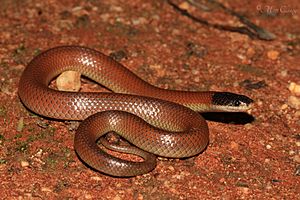Whip snake facts for kids
Quick facts for kids Whip snake |
|
|---|---|
 |
|
| Conservation status | |
| Scientific classification | |
| Genus: |
Suta
|
| Species: |
dwyeri
|
| Synonyms | |
|
|
The Whip snake (Suta dwyeri), also known as the Dwyer's snake or the variable black-naped snake, is a type of venomous snake. It belongs to the family called Elapidae. This snake is found only in Australia, living in areas from New South Wales to South Queensland. Even though it's related to Australian sea snakes, the Dwyer's snake lives on land.
Contents
Why is it Called Dwyer's Snake?
The specific name, dwyeri, honors an Australian expert on reptiles and amphibians named John Dwyer.
Its Changing Name
Over the years, the Dwyer's snake has had a few different scientific names. Scientists sometimes change names as they learn more about animals. For example, it was first called Denisonia dwyeri in 1956 by Eric Worrell. Later, it was known as Unechis dwyeri, then Suta dwyeri, and even Suta spectabilis dwyeri. In 2006, it was named Parasuta dwyeri by Allen Eddy Greer.
What Does the Dwyer's Snake Look Like?
Adult male Dwyer's snakes are usually about 31 cm (12 inches) long from their snout to the start of their tail. Females are a bit smaller, around 29 cm (11 inches) long. This snake has a brown body that is shaped like a cylinder, and it's usually slender to medium in build.
Its head is short and a bit wider than its neck, which helps you tell them apart. The tail is also short, and the scales on its back are smooth. It has medium-sized eyes with pupils that are shaped like a vertical oval.
Reproduction and Life Cycle
When it's time to have babies, male Dwyer's snakes are usually about 23 cm (9 inches) long, and females are around 22 cm (8.7 inches) long. This snake gives birth to live young, which is called viviparous. This means they don't lay eggs like some other snakes. A female Dwyer's snake usually has about three babies at a time. When they are born, the young snakes are about 13 cm (5.1 inches) long.
How Does the Dwyer's Snake Defend Itself?
Like other snakes in the family Elapidae, the Dwyer's snake is venomous. It has hollow fangs at the front of its upper jaw. These fangs are connected to venom glands near its eyes.
Most Australian elapid snakes, including the Dwyer's snake, are not aggressive and are mostly harmless. Experts at the Queensland Museum describe the Dwyer's snake as "weakly venomous." They don't include it in their list of snakes in the Brisbane area that could cause a deadly bite.
One person described being bitten by a Dwyer's snake: "The bite did not hurt at all. But little did I know he had left his fang in my finger. A couple of days later it got a tiny bit infected and hurt for a couple of days... nothing major though."
When it feels threatened, the Dwyer's snake likes to coil itself into a tight ball. This defense mechanism helps protect its head and other sensitive parts of its body from larger predators.
Where Does the Dwyer's Snake Live and What Does It Do?
The Dwyer's snake is a shy snake that is active at night, which means it is nocturnal. During the day, it hides under rocks, fallen leaves, and other things on the ground. It might also live in burrows that other animals have made and then left. Its favorite natural habitats are open woodlands, grasslands, and rocky areas.
What Does the Dwyer's Snake Eat?
The Dwyer's snake mainly eats small lizards. Its diet includes creatures like geckos and skinks.


